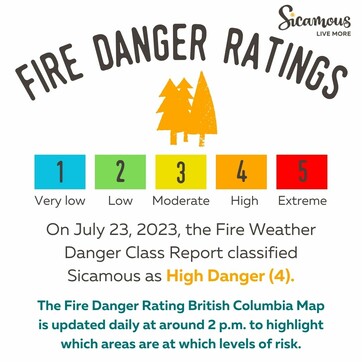
The BC Wildfire Service operates around 260 weather stations which send hourly reports. These reports are used for fire forecasting and the Canadian Forest Fire Danger Rating System (CFFDRS). A detailed danger class report provides estimated and forecasted fire danger rating values for specific weather stations.
The danger class is updated every day around 2 p.m. based on weather station data collected from around the province.
Resources:
- FireSmart BC
- Resources to prepare yourself, your family and your property for wildfire.
- Comprehensive breakdown of fire danger ratings.
- BC Wildfire Services
- Information on fire danger.
- Fire danger rating map updated each day around 2 p.m.
- Detailed danger class report for each fire centre.
- Sicamous is located in the Kamloops Fire Centre.
Please note that fire danger ratings provide restrictions for high-risk activities.
Here are three steps to determine your responsibilities around high risk activities.
1) Determine whether your proposed activity is a high risk activity.
According to Wildfire Regulation, the following are considered high risk activities:
- mechanical brushing;
- disk trenching;
- preparation or use of explosives;
- using fire or spark-producing tools, including cutting tools;
- using or preparing fireworks or pyrotechnics;
- grinding, including rail grinding;
- mechanical land clearing;
- clearing and maintaining rights of way, including grass mowing;
- any of the following activities carried out in a cutblock excluding a road, landing, roadside work area or log sort area in the cutblock:
- operating a power saw;
- mechanical tree felling, woody debris piling or tree processing, including de-limbing;
- welding;
- portable wood chipping, milling, processing or manufacturing;
- skidding logs or log forwarding unless it is improbable that the skidding or forwarding will result in the equipment contacting rock;
- yarding logs using cable systems.
If your proposed activity is listed above, proceed to Step 2.
2) Find out what the fire danger rating is at your proposed location of operation.
Those conducting high risk activities are required to use representative weather data to determine the fire danger rating for their location. You can get this data from:
- Internal weather stations
- Other third parties
- Detailed fire danger ratings provided for every BC Wildfire Service station
You can also gain access to daily fire weather data and forecasts from the BC Wildfire Service using a BCeID. Here's how to get a BCeID:
- Register for a BCeID
- Contact your fire centre or HPR.1800@gov.bc.ca, Superintendent, Fire Weather, with the following information:
- Name
- BCeID username
- Company name
- Position with the company
- Company address
- Contact phone number
- Email address
Once you have determined the fire danger rating at you proposed location of operation, you can assess the restrictions on the high risk activity.
3) Determine whether there are restrictions on the high risk activity.
Schedule 3 of the Wildfire Regulation outlines restrictions on high risk activities.
From the Government of British Columbia High Risk Activities webpage:
|
Fire Danger Class (DGR) |
Restriction |
Duration |
|---|---|---|
|
III |
After 3 consecutive days of DGR III or greater, implement a fire watch immediately after the high risk activity ends for a minimum of one hour. |
Until after the fire danger class falls below DGR III. |
|
IV |
Implement a fire watch immediately after the high risk activity ends for a minimum of two hours. |
Until after the fire danger class falls to DGR III for 2 consecutive days or falls below DGR III. |
|
|
After 3 consecutive days of DGR IV, cease activity between 1 p.m. PDT (Pacific Daylight Savings Time) and sunset each day. |
Until after the fire danger class falls to DGR III for 2 consecutive days, or falls below DGR III. |
|
V |
Cease activity between 1 p.m. PDT (Pacific Daylight Savings Time) and sunset each day and implement a fire watch immediately after the high risk activity ends for a minimum of two hours. |
Until after the fire danger class falls below DGR IV for 2 or more consecutive days. |
|
|
After 3 consecutive days of DGR V, cease activity all day. |
Until after the fire danger class to DGR IV for 3 or more consecutive days or falls below DGR IV. |
